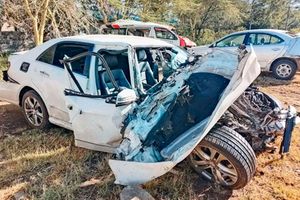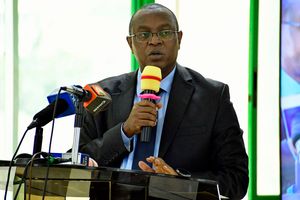Premium
Toyota Probox turned "ambulance" exposes counties' health crisis

Chemaner Ward Member of the County Assembly Richard Ruto besides a Toyota Probox vehicle he donated to a health centre as an "ambulance " in this photo taken on March 22, 2024.
What you need to know:
- Toyota Probox was donated to Chemaner ward, Bomet by MCA, Richard Ruto.
- Mr Ruto’s unconventional gesture has ignited a fierce debate within the local community, raising questions about the adequacy of healthcare resources and the responsibilities of civic leaders.
The Toyota Probox is a common sight on Kenyan roads, known for its versatility and affordability.
The compact vehicle is used for various everyday tasks, from ferrying passengers to transporting goods and has become an indispensable part of daily life for many Kenyans in both rural and urban centres.
However, in Bomet County's Chemaner ward, the humble Probox has transformed into a symbol of hope and controversy in the healthcare sector.
Faced with the stark realities of healthcare access in his ward where patients often struggle to reach medical facilities due to rugged terrain and poor road networks, Chemaner MCA Richard Ruto took matters into his own hands.
He purchased a Toyota Probox and donated it to Chemaner Health Centre, not as a conventional vehicle for everyday use, but as an ‘ambulance’.
It was a personal donation ostensibly aimed at bolstering emergency medical services but has now divided opinion among residents and stakeholders alike.
“When I bought, branded and donated the Toyota Probox, I did not expect it to generate this kind of mixed reaction. I wish to clarify that the motor vehicle is a rescue vehicle and not an “ambulance” as has been claimed,” Mr Ruto said.
He went on: “The reality on the ground is that due to the rough terrain, poor road network, the people are unable to access health facilities in what has seen expectant mothers give birth on the roadside.”
The vehicle’s rear seats were removed and the space was remodelled to accommodate a patient in a lying position while the driver and an extra passenger sat on the front seats.
While some applaud the MCA's initiative as a well-intentioned effort to address the pressing needs of the health sector, others view it as a misguided and inadequate solution to a complex problem.

Mr Richard Ruto, the Chemaner Ward Member of the County Assembly (second right) with health workers at Chemaner health centre in Bomet East constituency on March 22, 2024.
Mr Ruto’s unconventional gesture has ignited a fierce debate within the local community, raising questions about the adequacy of healthcare resources and the responsibilities of civic leaders.
The MCA feels that the national and county governments should allocate more resources to the health sector to make Universal Health Care (UHC) a reality, especially in rural areas.
“The reality between in roll out of UHC is that in the villages the probability of dying for lack of transport and poor state of roads to hospitals is high. It is what I had in mind when I made the donation and handed over the logbook to the public facility,” Mr Ruto said in an interview.
Critics argue that a Toyota Probox, a compact passenger vehicle, falls short of the standards expected for ambulance transportation, particularly in emergencies.
Concerns have been raised about the vehicle's capacity to accommodate patients safely and provide the necessary medical support en route to healthcare facilities, especially during emergencies.
The controversy surrounding the donation has cast a spotlight on the challenges facing the healthcare sector in Bomet County, where shortages of ambulances and medical equipment have long been a source of frustration for both healthcare workers and residents.
Many argue that while the gesture is well-intentioned, it underscores the urgent need for more substantial investments in healthcare infrastructure.
“The county government which has taken over the vehicle will service the vehicle, employ a driver, pay for insurance cover and spare parts among others. This will help us in the delivery of universal health care to the people,” said Bomet Deputy Governor Shadrack Rotich.
He spoke after receiving the vehicle on behalf of Governor Hillary Barchok who was called for another urgent engagement. He was accompanied by County Executive for Health Dr Joseph Sitonik and Chief Officer Felix Langat.

A medical kit fitted into a Toyota Probox vehicle which Chemaner Ward, Bomet County, MCA donated as an "ambulance" on March 22, 2024.
“Chemaner Health Centre is fed by three other public facilities in the area, and the rescue vehicle will greatly help in transporting the sick to access medical services. We are looking forward to support from the county government to make this a success,” Mr Dancun Kiplangat Maritim, the chairman of the facility’s management committee, said.
He said the facility which serves 10,000 patients annually has enough land for expansion and upgrade to a sub-county level, but requires an incinerator and waste disposal facilities.
It also requires more nurses and clinical officers to deal with the increased workload due to its vast catchment and high population.
Ms Mary Koech, a resident of Chambori village said children, the elderly and expectant mothers had been subjected to a lot of suffering while seeking treatment due to the distance from one facility to the other.
“It is a sigh of relief for the residents of Chemaner ward, some of whom have succumbed to diseases and injuries for failure to be taken to hospital in good time. This might not be the ultimate solution, but it is a major stride towards saving lives,” Ms Koech said.
But Mr Peter Cheruiyot, a resident is among those who have poked at the gesture saying it was the work of the county government to provide ambulances and drugs to the residents and not individuals.
“The fact that an MCA has donated a saloon vehicle which has been received and deployed to a health facility by the county government is a clear demonstration of how the devolved government unit has abdicated its duties,” Mr Cheruiyot, a youth said.
On her part, Ms Beatrice Koech said it would be difficult for the vehicle, though fitted with a stretcher, a medical kit and a siren to deal with emergency cases due to the small space with little room for the paramedic to operate from, to operate.
Most health facilities in the county do not have ambulances or any other mode of transport for patients to be brought in from their localities for treatment or transfer whenever they are on referral.

Ms Maureen Kirui, a resident of Kimogoro in Chemaner ward, Bomet county, says the 'ambulance' Toyota Probox would go a long way in alleviating the suffering of patients who have been unable to access medical services.
“We may laugh at this, but it is actually an improvement from the hand carts and motorcycles (boda boda) that are usually used by residents to carry the sick to hospital,” Mr Richard Kirinyet, a resident, said.
The county has four ambulances it manages after it terminated a lease arrangement in 2020 for six of the state-of-the-art ambulances that had been in use since 2014.
Longisa County Referral Hospital, the top public health facility in the county is the only government institution that deals with referral cases.
The referral cases usually spill over to Tenwek Hospital, owned by the African Gospel Church and supported by Christian-based religious organisations from the United States of America. Complicated cases are referred to the Nairobi-based Kenyatta National Hospital (KNH) or the Moi Teaching and Referral Hospital (MTRH) in Eldoret, Uasin Gishu County.
As the debate rages on, stakeholders continue to grapple with fundamental questions about the adequacy of healthcare resources and the role of civic leaders in addressing public needs.





